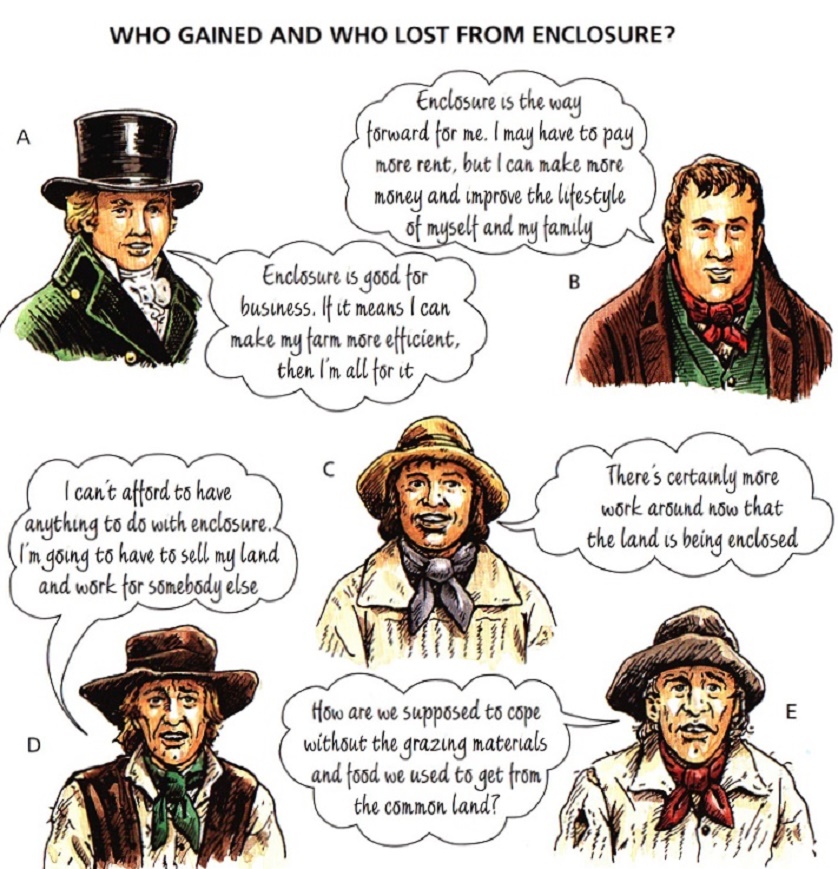
Effects of Enclosure - textbook comments
1 Traditional rhyme
The law arrests the man or woman
Who steals the goose from off a Common,
But
sets the grearter criminal loose
Who steals the Common from the goose.
2 Arthur Young, General Report on Enclosures, 1808
"There is however one class of farmers which have undoubtedly suffered enclosures, for they have been greatly lessened in number; these are the little farmers... That it is a great hardship suddenly to turn several, perhaps many of these poor men, out of their business, and reduce them to the day-labourers, would be idle to deny.
3 Karl Marx, Das Kapital, 1867
The labourers are first driven from the land, and then come the sheep. Landgrabbing on a great scale, such as was perpetrated in England, is the first step in creating a field for the establishment of agriculture on a great scale ... the systematic theft of communal property was of great assistance in swelling large farms and in ‘setting free’ the agricultural population as a proletariat for the needs of industry.
4 BH and JL Hammond, The Village Labourer, 1911
Enclosure was fatal to three classes: the small farmer, the cottager, and the squatter.
5 James Clifford, Aspects of Economic Development, 1967
ECONOMIC EFFECTS
Generally these are considered favourable since the wealth-producing capacity of the land was improved and hence gains were available to the population.
(a) Enclosures removed some of the major weaknesses of the open-field system since they increased the total acreage available for farming (especially by bringing commons and pastures under production).
(b) They encouraged people to experiment on the land; this gave it a more vaned use and so further helped to Improve
its fertility.
(c) The new pioneer ideas including Improvements in stock, seeds and implements, along with the greater variety,
increased the yield of each acre (although it must be remembered that general diffusion of knowledge was slow and costs of making improvements were sometimes prohibitive).
(d) The large capitalist was most important in this respect, for he had money to carry out improvements and gained from long leases, higher rents, improved roads to market produce, etc.
In general, there was more land available for food production, a greater yield to the soil and this more and a greater variety of food for the population.
SOCIAL EFFECTS
These are generally considered less favourable although to state this is to oversimplify somewhat, since there were venous factors involved.
(a) The effect on the yeoman farmer was considerable, although it must be remembered that his position was declining before enclosure started, and was by no means catastrophic; nevertheless, much of the burden of improvement fell on him and he found it a strain.
(b) The tenant farmer was often In a worse
position, for though it was not actually his
land he was expected to carry out some
improvement and this often meant going into
debt,.
(c) The farm labourers were most badly hit, for they not only found work more difficult, but they lost many common
rights (even considering compensation) and a large degree of independence, to such an extent that they often left the land altogether.
6 Peter Moss, History Alive 2, 1970
All of this sounds like the wicked, greedy, rich men oppressing the unhappy poor, and to a certain extent this is true.
But there is another side to the enclosure picture. The villagers were often stubborn, small-minded men who refused any change, however much It was to their good. Their old three-field system had worked in the days when England was a thinly-populated country of tiny isolated villages, but It was hopelessly out-of-date in a land growing rapidly in power and trade.
England had to have more food, and if the old methods could not provide it, then new ones had to be found however hard they may have seemed at the time.
7 Mark Overton, Agricultural Revolution in England, 1996
After the Second World War, revisionist historians argued that enclosure did no harm to the small farmer and that the peasantry had already disappeared.
JD Chambers (1967) considered that enclosure resulted in more employment not less, because of the extra work of hedging and ditching at the time of enclosure and the subsequent adoption of labour-intensive fodder crops. Evidence of the number of owners recorded in the land tax and the amounts they were paying in tax was also used to show that the number of small owners appeared to increase rather than diminish with enclosure.
This revisionist view is now itself under revision... Recent research is now claiming that enclosure did indeed contribute to the creation of a class of landless labourers and to the disappearance of a distinctive social class from the countryside.
8 Ben Walsh, British Social and Economic History, 1997
... where A is a landowner, B a tenant farmer, D a smallholder, and C & E landless labourers.
